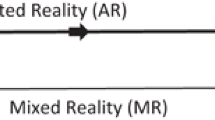Abstract
There are many different ways for people to be educated and trained with regard to specific information and skills they need. These methods include classroom lectures with textbooks, computers, handheld devices, and other electronic appliances. The choice of learning innovation is dependent on an individual’s access to various technologies and the infrastructure environment of a person’s surrounding. In a rapidly changing society where there is a great deal of available information and knowledge, adopting and applying information at the right time and right place is needed to main efficiency in both school and business settings. Augmented Reality (AR) is one technology that dramatically shifts the location and timing of education and training. This literature review research describes Augmented Reality (AR), how it applies to education and training, and the potential impact on the future of education.
Similar content being viewed by others
References
Azuma, R. T. (1997). A survey of augmented reality. Presence: Teleoperators and Virtual Environments 6, 4 (August 1997), 355–385. Cambridge, MA: The MIT Press.
Augmented reality. (n.d.). Retrieved from https://www.ssatrust.org.uk/achievement/future/pages/AugmentedReality.aspx
Billinghurst, M., Kato, H., & Poupyrev, I. (2001). The Magic Book — Moving seamlessly between reality and virtuality. IEEE Computers, Graphics and Applications, 21(3), 2–4.
Billinghurst, M. (2002). Augmented reality in education. New Horizons for Learning. Retrieved from http://www.newhorizons.org/strategies/technology/billinghurst.htm
Chae, C., & Ko, K. (2008). Introduction of physics simulation in augmented reality. ISUVR 2008 International Symposium on Ubiquitous Virtual Reality, 37–40.
Chang, G., Morreale, P., & Medicherla, P. (2010). Applications of augmented reality systems in education. In D. Gibson & B. Dodge (Eds.), Proceedings of Society for Information Technology & Teacher Education International Conference 2010, 1380–1385. Chesapeake, VA: AACE.
Duarte, M., Cardoso, A., & Lamounier Jr., E. (2005). Using augmented reality for teaching physics. WRA’2005 – II Workshop on Augmented Reality, 1–4.
Dünser, A., Steinbügl, K., Kaufmann, H., & Glück, J. (2006). Virtual and augmented reality as spatial ability training tools. Proceedings of the 7th ACM SIGCHI New Zealand chapter’s international conference on Computer-human interaction: design centered HCI, 125–132. Christchurch, New Zealand.
Fjeld, M., & Voegtli, B. M. (2002). Augmented chemistry: an interactive educational workbench. Proceedings of the international symposium on mixed and augmented reality (ISMAR ’02). Darmstadt, Germany.
Freitas, R., & Campos, P. (2008). SMART: a System of augmented reality for teaching 2nd grade students. Proceedings of the 22nd British Computer Society Conference on Human-Computer Interaction (HCI 2008), 27–30. Liverpool John Moores University, UK.
Henderson, J., & Feiner, S. (2009). Evaluating the benefits of augmented reality for task localization in maintenance of an armored personnel carrier turret. Proc. Int. Symp. on Mixed and Augmented Reality (ISMAR ‘09), 2009, 135–144.
Johnson, L., Levine, A., Smith, R., & Stone, S. (2010). Simple augmented reality. The 2010 Horizon Report, 21–24. Austin, TX: The New Media Consortium.
Kaufmann, H. (2009). Dynamic differential geometry in education. Journal for Geometry and Graphics, 13(2), 131–144.
Kaufmann, H., & Dünser, A. (2007). Summary of usability evaluations of an educational augmented reality application. Second International Conference, ICVR 2007. Beijing, China.
Kerawalla, L., Luckin, R., Seljeflot, S., & Woolard, A. (2006). Making it real: Exploring the potential of augmented reality for teaching primary school science. Virtual Reality, 10(3–4), 163–174. London, United Kingdom: Springer-Verlag London Ltd.
Kondo, T. (2006), Augmented learning environment using mixed reality technology, Proc. E-Learn, 83–88.
Liarokapis, F., Mourkoussis, N., White, M., Darcy, J., Sifniotis, M., Petridis, P., . . . Lister, P. (2004). Web3D and augmented reality to support engineering education. World Transactions on Engineering and Technology Education, 2004 UICEE Vol. 3. No. 1. Melbourne, Australia.
Schrier, K. L. (2005). Revolutionizing history education: using augmented reality games to teach histories. Master Thesis, Massachusetts Institute of Technology, Cambridge, MA.
Shelton, B. E. (2002). Augmented reality and education: Current projects and the potential for classroom learning. New Horizons for Learning. Retrieved from http://www.newhorizons.org/strategies/technology/shelton.htm
Shelton, B. E., & Hedley, N. R. (2002). Using augmented reality for teaching Earth-Sun relationships to undergraduate geography students. The First IEEE International Augmented Reality Toolkit Workshop. Darmstadt, Germany.
Shelton, B. E., & Hedley, N. R. (2004). Exploring a cognitive basis for learning spatial relationships with augmented reality. Technology, Instruction, Cognition and Learning, 1(4), 323–357. Philadelphia, PA: Old City Publishing, Inc.
Sutherland, I. (1968). A head-mounted three-dimensional display. Proceedings of Fall Joint Computer Conference, 1968, 757–764.
Vlahakis, V., Ioannidis, N., Karigiannis, J., Tsotros, M., Gounaris, M., Almeida, L., . . . Christou, I. (2002). ARCHEOGUIDE: First results of an augmented reality, mobile computing system in cultural heritage sites. Computer Graphics and Applications, IEEE, 52–60.
Wichert, R. (2002). A mobile augmented reality environment for collaborative education and training. In M. Driscoll & T. Reeves (Eds.), Proceedings of World Conference on E-Learning in Corporate, Government, Healthcare, and Higher Education 2002, 2386–2389. Chesapeake, VA: AACE.
Zhou, F., Duh, H. B. L., & Billinghurst, M. (2008). Trends in augmented reality tracking, interaction and display: A review of ten years of ISMAR. IEEE International Symposium on Mixed and Augmented Reality, 15–18. Cambridge, UK.
Author information
Authors and Affiliations
Rights and permissions
About this article
Cite this article
Lee, K. Augmented Reality in Education and Training. TECHTRENDS TECH TRENDS 56, 13–21 (2012). https://doi.org/10.1007/s11528-012-0559-3
Published:
Issue Date:
DOI: https://doi.org/10.1007/s11528-012-0559-3




